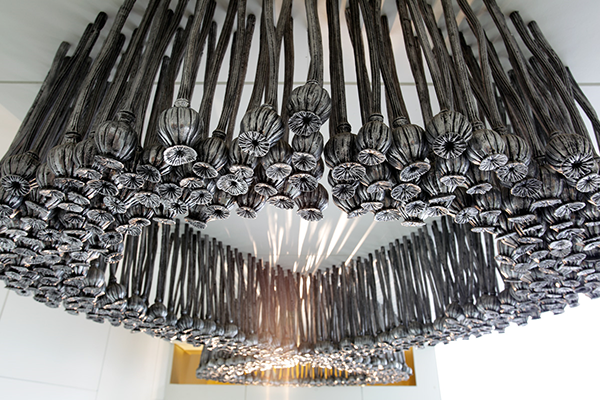Associate Professor Fiona Foley
Art connects. It connects us to our past, our present and our future. It connects us with bold ideas and challenging conversations. And it connects us to communities that help our conversations and ideas to develop.
With the launch of UQ Arts we want to connect you to the creators, curators, scholars and publishers dedicated to capturing stories and ideas through creative expression.
Meet Associate Professor Fiona Foley. Recognised for her outstanding contribution to the development of Australian art, Dr Foley is an Indigenous artist with an international reputation and the creative force behind numerous major public art projects in the country.
Now working as a Principal Research Fellow in the School of Historical and Philosophical Inquiry, Dr Foley was recently awarded an Australian Research Council DECRA for her project “Investigating the Agency of Aboriginal Frontier War Memorials.”
She plans to use this funding to make 14 short films and publish a book through UQ Press over the next 3 years.
“Aboriginal people have the right to remember, and I plan to interview descendants talking about frontier wars and their particular history on country,” she said.
Dr Foley began her journey at The University of Queensland through her appointment as an Adjunct Professor and the project Courting Blakness (2011 – 2014).
The public art exhibition in the Great Court built upon UQ’s tradition of leadership to create new art, new knowledge, and new relationships between Indigenous and non-Indigenous people.
During her time on the project, she was inspired by one of the other artists in the curatorial team, Ryan Presley, who was in the midst of his PhD.
“I had just turned 50 and thought, I want a new challenge in life – the time was right to go back into higher education,” Dr Foley said.
So, she did. And began tackling her PhD which explored historical opium use in Queensland.

“There is a piece of legislation The Aboriginals Protection and Restriction of the Sale of Opium Act and it made me wonder what opium was doing in Queensland and what it had to do with Aboriginal people.
“I learned that the prevalence of opium and government control was a catalyst for removing Aboriginal people off their land and was a part of their forced removals into missionary settlements.
“They were being supplied opium ash to addict them as a free labour force. It was enslavement through addiction,” she said.
Dr Foley’s PhD was published by UQP in 2020. Biting the Clouds: A Badtjala perspective on the Aboriginals Protection and Restriction of the Sale of Opium Act, 1897 won the Queensland Literary Award for the Queensland Premier’s Award for a Work of State Significance (2021).
Having always worked through mixed mediums, Dr Foley explains interlacing creativity and academia.
“Although creative artwork gives you the freedom to blur lines between truth and magical realism; academic work is different.
“We have a right to use the visual arts to articulate what we’re interested in terms of research and how we can bring that into our projects,” she said.
A strong advocate for arts and humanities, Dr Foley said this is a legitimate way to investigate questions about history, our democracy, Indigenous rights, and new knowledges that are coming to the fore.
“If we are inclusive of the visual arts then we have a larger platform to speak from.”
Dr Foley has always been inspired by her mother, who placed a high importance on education.
“She used to say: you can’t fight them with boomerangs and spears anymore, you need to get an education and compete on a level playing field.”

Books were always valuable in Dr Foley’s family. Her great Uncle Wilfie and Great Aunty Olga wrote and illustrated the first Aboriginal Children’s book in 1964, The Legends of Moonie Jarl.
“It was, and still is to this day, treasured in our family.
“As a child I used to look at the unusual illustrations in that publication and be completely fascinated by the drawings that my Great Aunty had made.
“I have never seen anything like it before or since,” she said.
The Legends of Moonie Jarl was reprinted again with the Indigenous Literacy Foundation when it turned 50 – a wonderful acknowledgement of the publication.
The Arts has been Dr Foley’s identity for the longest time. She started to get an inkling of moving in the art direction when she was in Grade 6, so the pull was strong from an early age.
She moved onto Art School and began life as a practicing artist freelancing.
“It’s part of who I am, I live and breathe art. It’s how I view the world and how people view me, through the art that I make.”
Dr Foley thinks the vision for UQ Arts could be quite substantial.
“I think we could dream big about how it could look and how we position ourselves in the future.
“For me, my passion is visual arts, but other people are writers and musicians and UQ Arts is a fabulous initiative to bring us all together,” she said.
Dr Foley has not only made substantial contributions to the visual arts sector for many years, but has also inspired other artists and arts professionals both here and overseas.
Her work examines issues of race, politics and history on a regional, national and international level and challenges historical stereotypes; encouraging debate between artists and communities in Australia and internationally.


Principal Research Fellow
School of Historical and Philosophical Inquiry
Faculty of Humanities, Arts and Social Sciences
